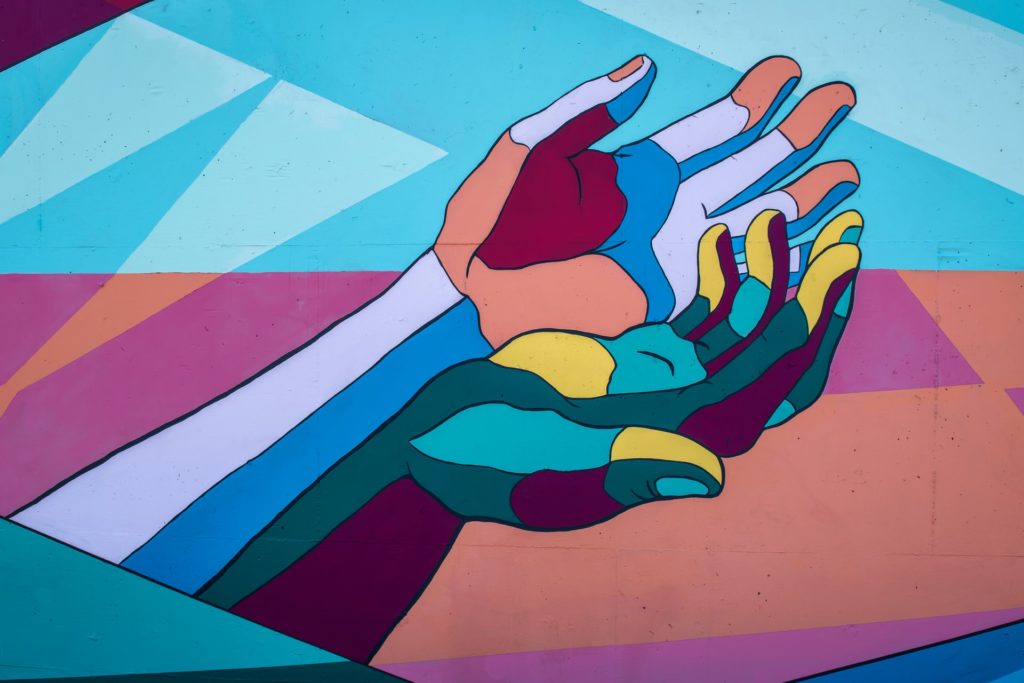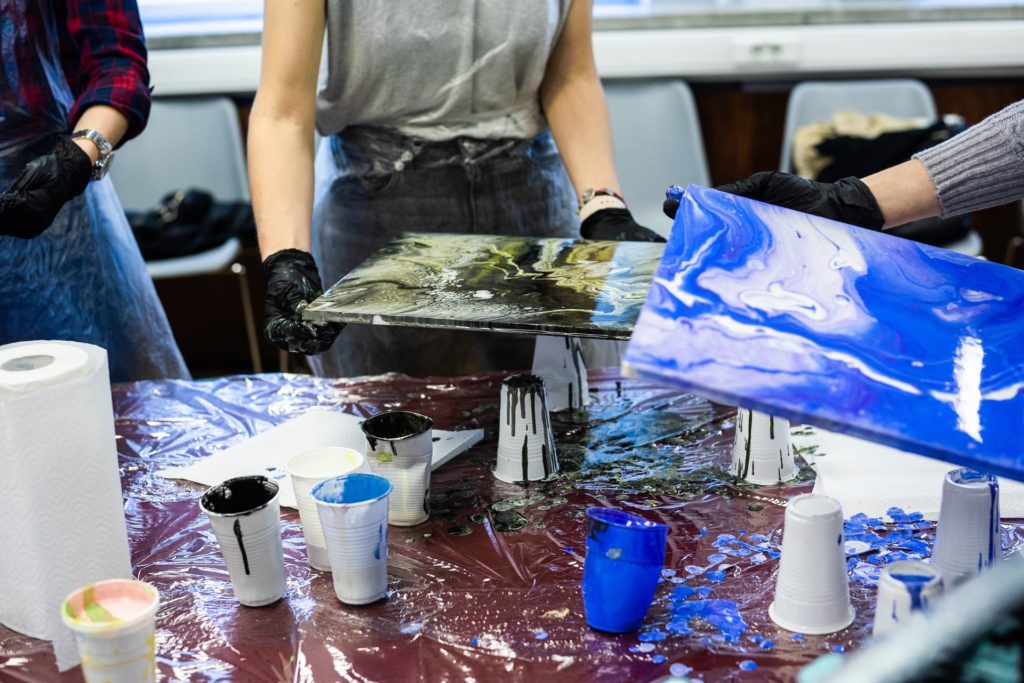First thing to know is that you don’t need to be an artist to benefit from art therapy.
Art Therapy combines the creative process with psychotherapy to help people delve into their own self-exploration and know themselves better.
It can be easily confused with Expressive Arts Therapy.
An arts therapist uses poetry, music, dance, and even art therapies to help with clients’ mental health.
Art therapy professionals use various media to create visual art while working with people.
By using imagery, colour, and shape, thoughts and feelings rise up to surface and be expressed and examined with a qualified art therapist.
Creative techniques, such as drawing, painting, collaging, drawing, or sculpting work with significant results to improve a person’s physical, mental health, and emotional well-being.
A R T Therapy is Accelerated Resolution Therapy, which could be further confusing, is another mental health therapy used for PTSD and other psychiatric conditions.
It is derived from EMDR therapy (Eye Movement Desensitization and Reprocessing), yet has a tighter protocol, is more directive, more procedural, and easier to learn.
Let’s dive into it:

How Does Art Therapy Work?
“Creativity in and of itself is important for remaining healthy, remaining connected to yourself and connected to the world,” says Christianne Strang, a professor of neuroscience at the University of Alabama Birmingham and former president of the American Art Therapy Association.
Founded in 1969, the American Art Therapy Association is one of the world’s leading art therapy membership organizations.
Creating artwork changes brain wave states in people.
It takes you from a very active or stressed beta level to alpha and theta brain wave states in the frontal and central areas of the brain.
This is when you’re in “flow”. You have a sense of losing yourself in a task, losing awareness of time and everything else in your outer environment. You are in the moment and fully present forgetting all sense of time and space.
This video demonstrates how art therapy can work to change peoples’ mood in just one session.
While working with different media, a therapist asks questions to reveal the underlying personal meaning in a person’s artwork. This brings remembrances and wisdom to surface from the subconscious mind.
Art therapy helps you:
- Imagine a more hopeful future
- Activate the reward centre of the brain
- Lower stress
- Focus deeply for profound realizations
- Process your emotions
It’s truly amazing how much people learn about themselves in a session. Working with a specific media could also ignite a passion for creating art.
How Much Does An Art Therapy Session Cost?
An art therapy session ranges between $100 – $125 per hour.
Many art therapists will offer group sessions which may be more affordable for some at about $45 – $65 per hour.
Some insurance plans also offer payment for art therapy.
Student pricing is offered in some clinics.
For example, one clinic in British Columbia, Canada offers Student Nights for $20 an hour.
A student in counselling and art therapy will support a student client.
How To Become An Art Therapist
First, plan for a master’s degree in art therapy and certification in order to practice.
Art therapy requires that a student know visual art forms – drawing, painting, sculpture, etc. – using various media, as well as creative processes.
Students will also learn an understanding of line, colour, space, and perspective.
In order to improve peoples’ mental health, an art therapy professional also requires knowledge of human development and psychology, and counselling theories and processes.
So an undergraduate degree in fine art, psychology, social work, or counselling is a good beginning.
During an admissions process, it would benefit prospective students to demonstrate an understanding and an interest in visual arts, as well as creative processes.
For this, a portfolio may be a requirement or having an interview with someone from the program.
In order to begin practicing art therapy you will have earned at least a master’s degree from an accredited institution.
Some institutions also offer online training for art therapy.

Art Therapy Certification
While graduating from a master’s program in art therapy is enough to allow you to begin working in an entry-level practice, applying to your professional association to get an art therapy certification will make you a registered art therapist.
The Art Therapy Credentials Board was established in 1993.
Their web page lists the primary goal is to protect the public by ensuring art therapy professionals gather and maintain ethical and quality standards.
This is done by offering three professional credentials to anyone practicing art therapy:
- Registered Art Therapist (ATR)
This credential confirms the therapist has satisfactorily completed graduate-level courses in art therapy and has clinical experience under a qualified guide.
- Board Certified Art Therapist (ATR-BC)
This is the highest credential an art therapist can earn. This shows a completion in a national exam demonstrating an understanding of clinical skills and theories associated with art therapy.
- Art Therapy Certified Supervisor (ATCS)
This is an advanced supervisory credential earned by Board Certified Art Therapists.
For international information visit the web page of Global Art Therapy Alliance.
How Much Does An Art Therapist Make?
The U.S. Bureau of Labour Statistics classifies art therapy as recreational therapy.
An average salary as of May 2017 was $49,670. Professionals in the top 10% of wage earners, on average, earned $74,210.
Nuevoo, a job search engine, estimates art therapy careers can net a salary between $56,000 and $85,000 per year.
Art therapy professionals working in big cities generally make more than those in smaller towns.
Best Ways To Find An Art Therapist Near Me?
It’s best to search for a therapist who has certified credentials and experience.
The American Art Therapy Association has a comprehensive search engine listing art therapy professionals in different U.S. areas.

A List of Best Art Therapists in the US
Here is a listing of several top art therapists in different areas of the United States:
| Hilary Chermak, ATR-BCAcadia Family Center1 Fernald Point Rd. Southwest Harbor, Maine207-244-4012 Sheilagh McGreal, ATRRochester Art Therapy595 Blossom Road, #310 Rochester, New York585-420-8494 Nina Salzberg, ATRChildSavers200 N 22nd StRichmond, Virginia804-591-3916 Crista (Cristina) Coffing-Blain, ATRJacksonville Art Therapy2380 3rd Street South, Suite 2Jacksonville Beach, Florida904-853-0680 Tessa Banta, ATR-BCBridgehaven4100 950 S. First StreetLouisville, Kentucky502-585-9444 Kathleen M. Buday, ATR-BCUniversity of Wisconsin, Superior3780 London RoadDuluth, Minnesota269-762-3170 Lynn Flint Widdifield, ATR-BC1811 W 2ND ST 310Grand Island, Nebraska308-381-0787 Beth Morale, ATR-BCBeth Morale, LPC, ATR-BC9535 Forest Ln.,Dallas, Texas214-923-7872 Seema Bacon, ATRTaproot Therapy2111 East Baseline Road, Suite D2Tempe, Arizona480-307-6446 Rosalie Frankle, ATR-BCSeattle Children’s HospitalMA 4121 PO box 5371Seattle, Washington206-987-1827 | Stephanie Musial, ATR-BCCreative Bridges, LLC14 Cedar Street, Suite 203,Amesbury, Massachusetts978-290-0042 Rhonda Stern, ATR-BCRhonda Stern, MA, ATR-BC, LPC700 E. Beaver Ave. Suite #2 State College, Pennsylvania814-861-4577 Alyssa Millard, ATRNurturing Arts7 Gamecock Ave Suite 706Charleston, South Carolina843-259-5609 Susan Ainlay-Anand, ATR-BCUniversity of Mississippi Medical Center, Department of Psychiatry & Human Behavior2500 North State Street Jackson, Mississippi601-984-5789 Autumn Heddy-Reed, ATR-BCVoices for Children Advocacy Center515 East StreetFlint, Michigan810-233-3333, Ext. 214 Kimberly Brown Campbell, ATRKim Brown Campbell, EdD, LCPC, ATR, LLC235 N. 1st St. W., Studio 1Missoula, Montana406-396-6565 Natasha Young, ATR-BCTeleHealth Art Therapy Counseling & Supervision1605 Residence DriveColumbia, Missouri812-319-8422 Misti Vekas, ATR-BCPrivate Practice11051 S. Memorial Dr.Tulsa, Oklahoma918-369-9505 Deborah A.Goode, ATR-BC2489 Elfego Road,NW Albuquerque, New Mexico505-228-3410 Jennifer Allen, ATR-BCArt for Access26485 Carmel Rancho blvd #5Carmel, California831-277-9348 |
Related Posts
EMDR Therapy Near Me – A Complete Guide
What Does Hypnosis Feel Like?
